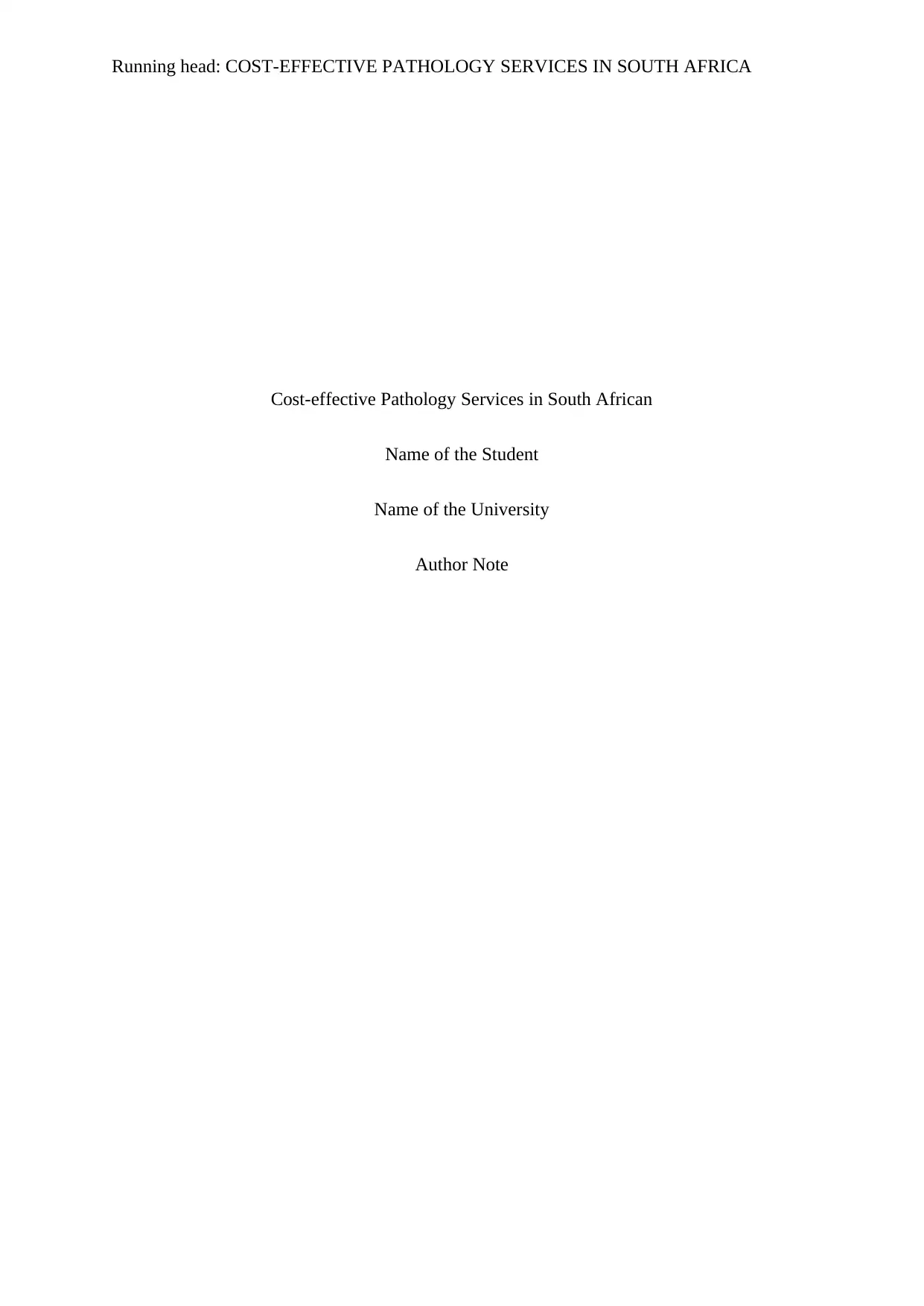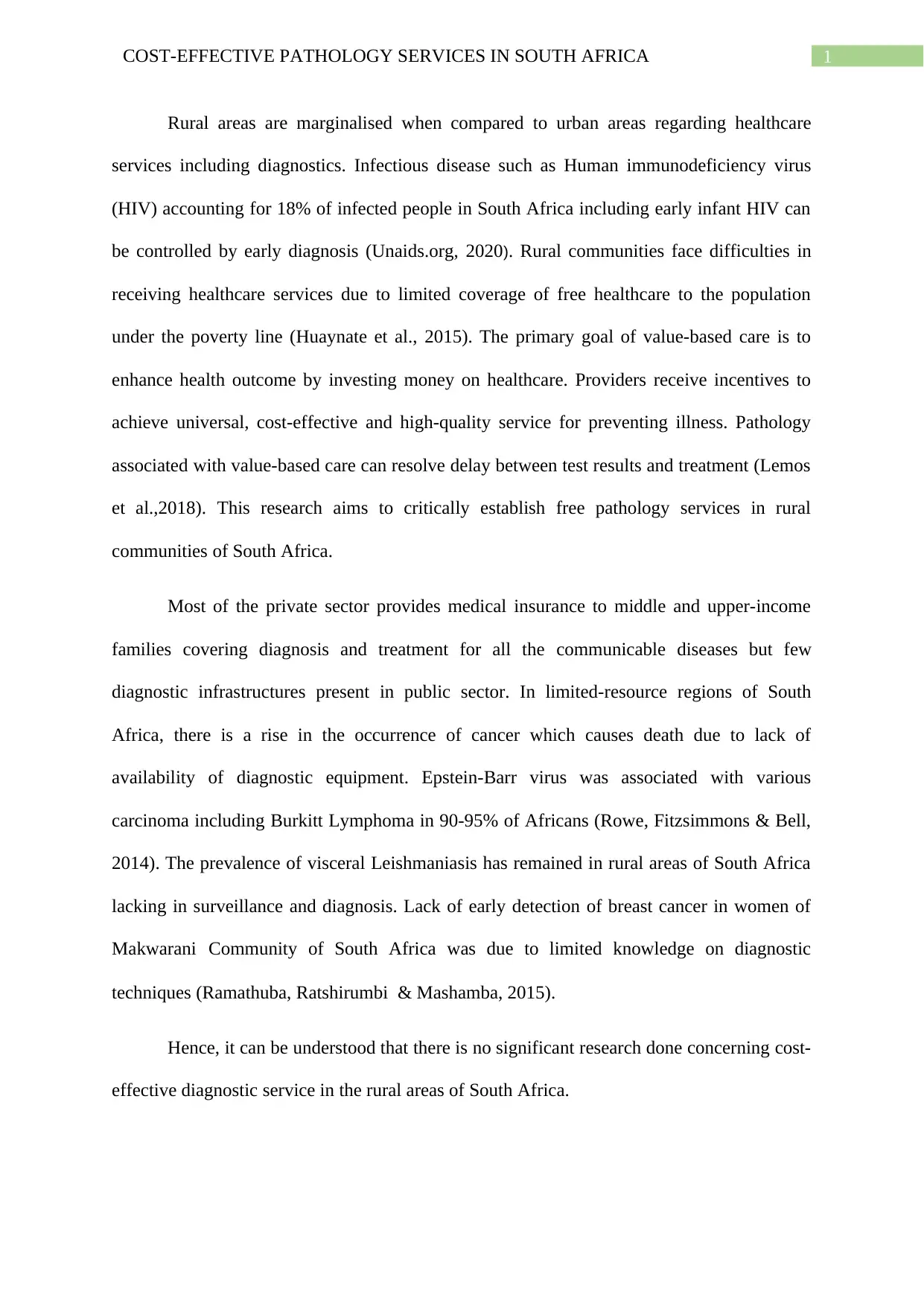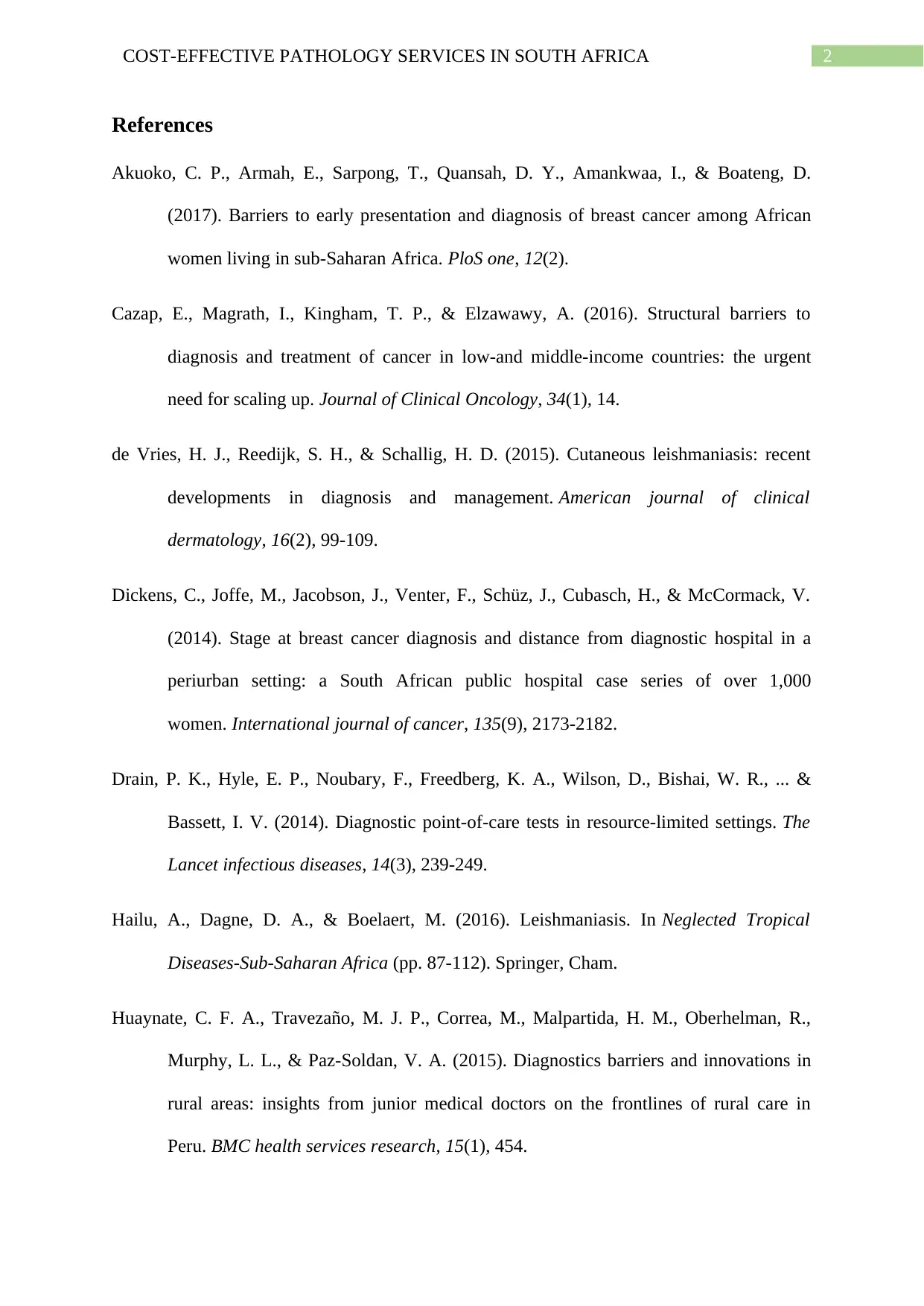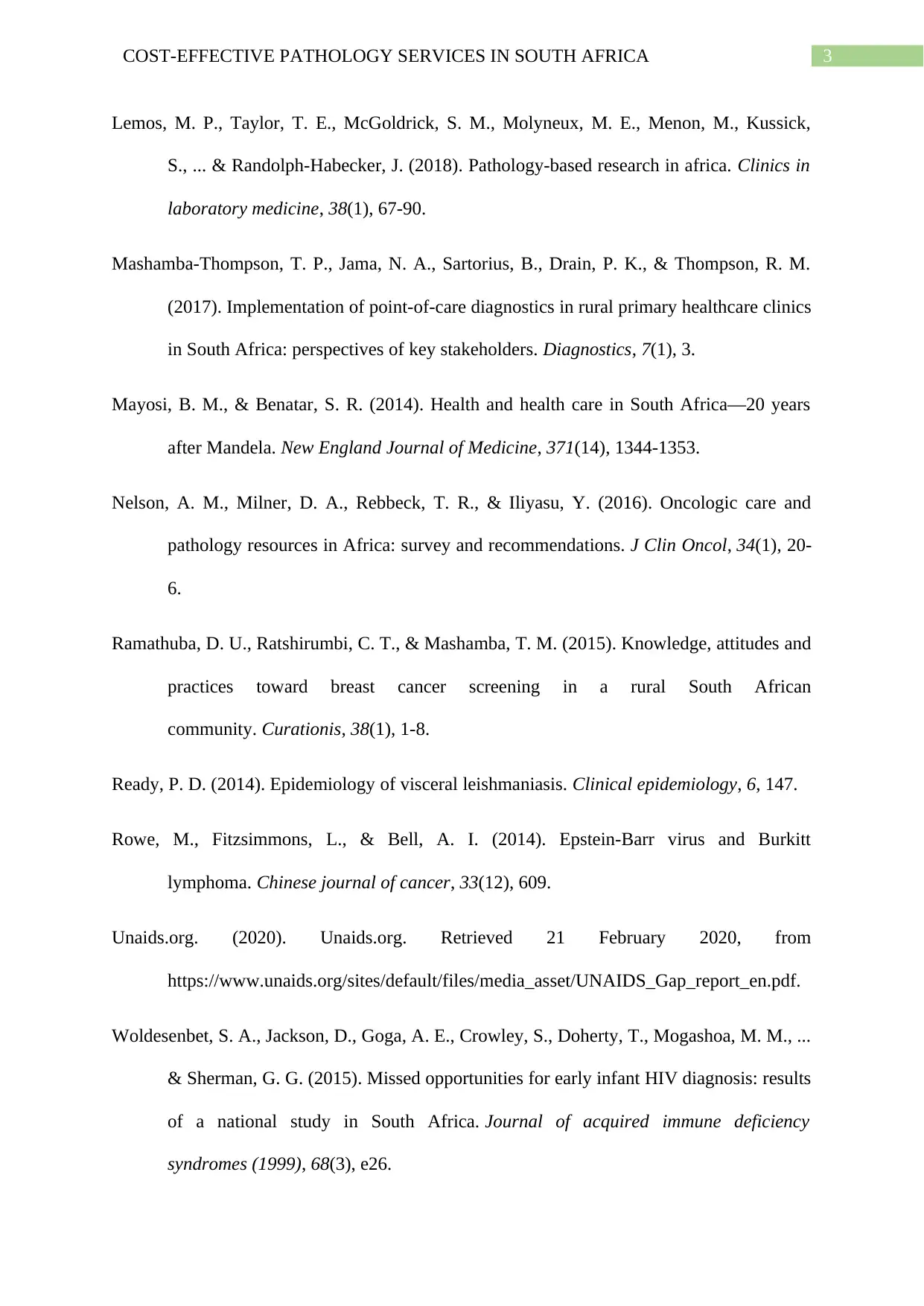Value-Based Care and Cost-Effective Pathology Services in South Africa
VerifiedAdded on 2022/08/08
|4
|1120
|21
Essay
AI Summary
This essay critically examines the need for cost-effective pathology services in rural communities of South Africa. The research highlights the disparity in healthcare access, particularly in diagnostic services, between urban and rural areas. The study emphasizes the impact of infectious diseases like HIV and the rising incidence of cancer in resource-limited regions. It proposes a new process for the delivery of pathology services in South Africa based on the principles of Value Based Care, aiming to improve health outcomes and address the challenges of limited diagnostic infrastructure. The essay references various studies to support the arguments and emphasizes the importance of early diagnosis and cost-effective solutions to improve healthcare delivery in the region, covering topics like breast cancer, Leishmaniasis and Epstein-Barr virus.

Running head: COST-EFFECTIVE PATHOLOGY SERVICES IN SOUTH AFRICA
Cost-effective Pathology Services in South African
Name of the Student
Name of the University
Author Note
Cost-effective Pathology Services in South African
Name of the Student
Name of the University
Author Note
Paraphrase This Document
Need a fresh take? Get an instant paraphrase of this document with our AI Paraphraser

1COST-EFFECTIVE PATHOLOGY SERVICES IN SOUTH AFRICA
Rural areas are marginalised when compared to urban areas regarding healthcare
services including diagnostics. Infectious disease such as Human immunodeficiency virus
(HIV) accounting for 18% of infected people in South Africa including early infant HIV can
be controlled by early diagnosis (Unaids.org, 2020). Rural communities face difficulties in
receiving healthcare services due to limited coverage of free healthcare to the population
under the poverty line (Huaynate et al., 2015). The primary goal of value-based care is to
enhance health outcome by investing money on healthcare. Providers receive incentives to
achieve universal, cost-effective and high-quality service for preventing illness. Pathology
associated with value-based care can resolve delay between test results and treatment (Lemos
et al.,2018). This research aims to critically establish free pathology services in rural
communities of South Africa.
Most of the private sector provides medical insurance to middle and upper-income
families covering diagnosis and treatment for all the communicable diseases but few
diagnostic infrastructures present in public sector. In limited-resource regions of South
Africa, there is a rise in the occurrence of cancer which causes death due to lack of
availability of diagnostic equipment. Epstein-Barr virus was associated with various
carcinoma including Burkitt Lymphoma in 90-95% of Africans (Rowe, Fitzsimmons & Bell,
2014). The prevalence of visceral Leishmaniasis has remained in rural areas of South Africa
lacking in surveillance and diagnosis. Lack of early detection of breast cancer in women of
Makwarani Community of South Africa was due to limited knowledge on diagnostic
techniques (Ramathuba, Ratshirumbi & Mashamba, 2015).
Hence, it can be understood that there is no significant research done concerning cost-
effective diagnostic service in the rural areas of South Africa.
Rural areas are marginalised when compared to urban areas regarding healthcare
services including diagnostics. Infectious disease such as Human immunodeficiency virus
(HIV) accounting for 18% of infected people in South Africa including early infant HIV can
be controlled by early diagnosis (Unaids.org, 2020). Rural communities face difficulties in
receiving healthcare services due to limited coverage of free healthcare to the population
under the poverty line (Huaynate et al., 2015). The primary goal of value-based care is to
enhance health outcome by investing money on healthcare. Providers receive incentives to
achieve universal, cost-effective and high-quality service for preventing illness. Pathology
associated with value-based care can resolve delay between test results and treatment (Lemos
et al.,2018). This research aims to critically establish free pathology services in rural
communities of South Africa.
Most of the private sector provides medical insurance to middle and upper-income
families covering diagnosis and treatment for all the communicable diseases but few
diagnostic infrastructures present in public sector. In limited-resource regions of South
Africa, there is a rise in the occurrence of cancer which causes death due to lack of
availability of diagnostic equipment. Epstein-Barr virus was associated with various
carcinoma including Burkitt Lymphoma in 90-95% of Africans (Rowe, Fitzsimmons & Bell,
2014). The prevalence of visceral Leishmaniasis has remained in rural areas of South Africa
lacking in surveillance and diagnosis. Lack of early detection of breast cancer in women of
Makwarani Community of South Africa was due to limited knowledge on diagnostic
techniques (Ramathuba, Ratshirumbi & Mashamba, 2015).
Hence, it can be understood that there is no significant research done concerning cost-
effective diagnostic service in the rural areas of South Africa.

2COST-EFFECTIVE PATHOLOGY SERVICES IN SOUTH AFRICA
References
Akuoko, C. P., Armah, E., Sarpong, T., Quansah, D. Y., Amankwaa, I., & Boateng, D.
(2017). Barriers to early presentation and diagnosis of breast cancer among African
women living in sub-Saharan Africa. PloS one, 12(2).
Cazap, E., Magrath, I., Kingham, T. P., & Elzawawy, A. (2016). Structural barriers to
diagnosis and treatment of cancer in low-and middle-income countries: the urgent
need for scaling up. Journal of Clinical Oncology, 34(1), 14.
de Vries, H. J., Reedijk, S. H., & Schallig, H. D. (2015). Cutaneous leishmaniasis: recent
developments in diagnosis and management. American journal of clinical
dermatology, 16(2), 99-109.
Dickens, C., Joffe, M., Jacobson, J., Venter, F., Schüz, J., Cubasch, H., & McCormack, V.
(2014). Stage at breast cancer diagnosis and distance from diagnostic hospital in a
periurban setting: a South African public hospital case series of over 1,000
women. International journal of cancer, 135(9), 2173-2182.
Drain, P. K., Hyle, E. P., Noubary, F., Freedberg, K. A., Wilson, D., Bishai, W. R., ... &
Bassett, I. V. (2014). Diagnostic point-of-care tests in resource-limited settings. The
Lancet infectious diseases, 14(3), 239-249.
Hailu, A., Dagne, D. A., & Boelaert, M. (2016). Leishmaniasis. In Neglected Tropical
Diseases-Sub-Saharan Africa (pp. 87-112). Springer, Cham.
Huaynate, C. F. A., Travezaño, M. J. P., Correa, M., Malpartida, H. M., Oberhelman, R.,
Murphy, L. L., & Paz-Soldan, V. A. (2015). Diagnostics barriers and innovations in
rural areas: insights from junior medical doctors on the frontlines of rural care in
Peru. BMC health services research, 15(1), 454.
References
Akuoko, C. P., Armah, E., Sarpong, T., Quansah, D. Y., Amankwaa, I., & Boateng, D.
(2017). Barriers to early presentation and diagnosis of breast cancer among African
women living in sub-Saharan Africa. PloS one, 12(2).
Cazap, E., Magrath, I., Kingham, T. P., & Elzawawy, A. (2016). Structural barriers to
diagnosis and treatment of cancer in low-and middle-income countries: the urgent
need for scaling up. Journal of Clinical Oncology, 34(1), 14.
de Vries, H. J., Reedijk, S. H., & Schallig, H. D. (2015). Cutaneous leishmaniasis: recent
developments in diagnosis and management. American journal of clinical
dermatology, 16(2), 99-109.
Dickens, C., Joffe, M., Jacobson, J., Venter, F., Schüz, J., Cubasch, H., & McCormack, V.
(2014). Stage at breast cancer diagnosis and distance from diagnostic hospital in a
periurban setting: a South African public hospital case series of over 1,000
women. International journal of cancer, 135(9), 2173-2182.
Drain, P. K., Hyle, E. P., Noubary, F., Freedberg, K. A., Wilson, D., Bishai, W. R., ... &
Bassett, I. V. (2014). Diagnostic point-of-care tests in resource-limited settings. The
Lancet infectious diseases, 14(3), 239-249.
Hailu, A., Dagne, D. A., & Boelaert, M. (2016). Leishmaniasis. In Neglected Tropical
Diseases-Sub-Saharan Africa (pp. 87-112). Springer, Cham.
Huaynate, C. F. A., Travezaño, M. J. P., Correa, M., Malpartida, H. M., Oberhelman, R.,
Murphy, L. L., & Paz-Soldan, V. A. (2015). Diagnostics barriers and innovations in
rural areas: insights from junior medical doctors on the frontlines of rural care in
Peru. BMC health services research, 15(1), 454.
⊘ This is a preview!⊘
Do you want full access?
Subscribe today to unlock all pages.

Trusted by 1+ million students worldwide

3COST-EFFECTIVE PATHOLOGY SERVICES IN SOUTH AFRICA
Lemos, M. P., Taylor, T. E., McGoldrick, S. M., Molyneux, M. E., Menon, M., Kussick,
S., ... & Randolph-Habecker, J. (2018). Pathology-based research in africa. Clinics in
laboratory medicine, 38(1), 67-90.
Mashamba-Thompson, T. P., Jama, N. A., Sartorius, B., Drain, P. K., & Thompson, R. M.
(2017). Implementation of point-of-care diagnostics in rural primary healthcare clinics
in South Africa: perspectives of key stakeholders. Diagnostics, 7(1), 3.
Mayosi, B. M., & Benatar, S. R. (2014). Health and health care in South Africa—20 years
after Mandela. New England Journal of Medicine, 371(14), 1344-1353.
Nelson, A. M., Milner, D. A., Rebbeck, T. R., & Iliyasu, Y. (2016). Oncologic care and
pathology resources in Africa: survey and recommendations. J Clin Oncol, 34(1), 20-
6.
Ramathuba, D. U., Ratshirumbi, C. T., & Mashamba, T. M. (2015). Knowledge, attitudes and
practices toward breast cancer screening in a rural South African
community. Curationis, 38(1), 1-8.
Ready, P. D. (2014). Epidemiology of visceral leishmaniasis. Clinical epidemiology, 6, 147.
Rowe, M., Fitzsimmons, L., & Bell, A. I. (2014). Epstein-Barr virus and Burkitt
lymphoma. Chinese journal of cancer, 33(12), 609.
Unaids.org. (2020). Unaids.org. Retrieved 21 February 2020, from
https://www.unaids.org/sites/default/files/media_asset/UNAIDS_Gap_report_en.pdf.
Woldesenbet, S. A., Jackson, D., Goga, A. E., Crowley, S., Doherty, T., Mogashoa, M. M., ...
& Sherman, G. G. (2015). Missed opportunities for early infant HIV diagnosis: results
of a national study in South Africa. Journal of acquired immune deficiency
syndromes (1999), 68(3), e26.
Lemos, M. P., Taylor, T. E., McGoldrick, S. M., Molyneux, M. E., Menon, M., Kussick,
S., ... & Randolph-Habecker, J. (2018). Pathology-based research in africa. Clinics in
laboratory medicine, 38(1), 67-90.
Mashamba-Thompson, T. P., Jama, N. A., Sartorius, B., Drain, P. K., & Thompson, R. M.
(2017). Implementation of point-of-care diagnostics in rural primary healthcare clinics
in South Africa: perspectives of key stakeholders. Diagnostics, 7(1), 3.
Mayosi, B. M., & Benatar, S. R. (2014). Health and health care in South Africa—20 years
after Mandela. New England Journal of Medicine, 371(14), 1344-1353.
Nelson, A. M., Milner, D. A., Rebbeck, T. R., & Iliyasu, Y. (2016). Oncologic care and
pathology resources in Africa: survey and recommendations. J Clin Oncol, 34(1), 20-
6.
Ramathuba, D. U., Ratshirumbi, C. T., & Mashamba, T. M. (2015). Knowledge, attitudes and
practices toward breast cancer screening in a rural South African
community. Curationis, 38(1), 1-8.
Ready, P. D. (2014). Epidemiology of visceral leishmaniasis. Clinical epidemiology, 6, 147.
Rowe, M., Fitzsimmons, L., & Bell, A. I. (2014). Epstein-Barr virus and Burkitt
lymphoma. Chinese journal of cancer, 33(12), 609.
Unaids.org. (2020). Unaids.org. Retrieved 21 February 2020, from
https://www.unaids.org/sites/default/files/media_asset/UNAIDS_Gap_report_en.pdf.
Woldesenbet, S. A., Jackson, D., Goga, A. E., Crowley, S., Doherty, T., Mogashoa, M. M., ...
& Sherman, G. G. (2015). Missed opportunities for early infant HIV diagnosis: results
of a national study in South Africa. Journal of acquired immune deficiency
syndromes (1999), 68(3), e26.
1 out of 4
Your All-in-One AI-Powered Toolkit for Academic Success.
+13062052269
info@desklib.com
Available 24*7 on WhatsApp / Email
![[object Object]](/_next/static/media/star-bottom.7253800d.svg)
Unlock your academic potential
Copyright © 2020–2025 A2Z Services. All Rights Reserved. Developed and managed by ZUCOL.

